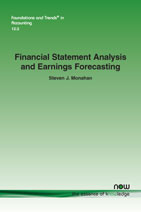Financial Statement Analysis and Earnings Forecasting
Steven J. Monahan, INSEAD, Europe Campus, Boulevard de Constance, France, steven.monahan@insead.eduAbstract
I synthesize and discuss academic research on financial statement analysis and earnings forecasting. I begin by discussing analytical and empirical evidence that shows that earnings, not dividends or free cash flows, are the payoffs that investors forecast when estimating value. This result is fundamental and it provides clear motivation for studying earnings forecasting and the role that historical accounting numbers play in the earnings-forecasting process. I then provide a detailed discussion of the research design choices that are made when developing and evaluating an earnings-forecasting approach. I describe the tradeoffs involved when making these choices and I review the extant empirical literature. An overarching theme of this discussion is that there are substantial research opportunities.
Financial Statement Analysis and Earnings Forecasting
Financial Statement Analysis and Earnings Forecasting is the process of analyzing historical financial statement data for the purpose of developing forecasts of future earnings. This process is important because it is central to the valuation of companies and the securities they issue. After a short introduction, Section 2 delves into the question “Why earnings”? Focusing on dividend policy irrelevance, the author describes key analytical results that imply that expected earnings are the fundamental determinant of both equity and enterprise value. Section 3 examines the issues involved in selecting the earnings metric to forecast. Once an earnings metric has been chosen, the next question to ask is “How useful are historical accounting numbers for developing forecasts of that metric?” Sections 4 through 8 focus on this question. Section 4 discusses the general role of econometric modeling. Section 5 reviews time-series models. Section 6 examines the choices a researcher makes when using panel-data approaches and the author describes the advantages of these approaches. Section 7 reviews the role of accounting measurement in determining the usefulness of historical accounting numbers for developing forecasts of future earnings. Section 8 examines approaches for forecasting the higher moments of future earnings and section 9 provides a summary.
